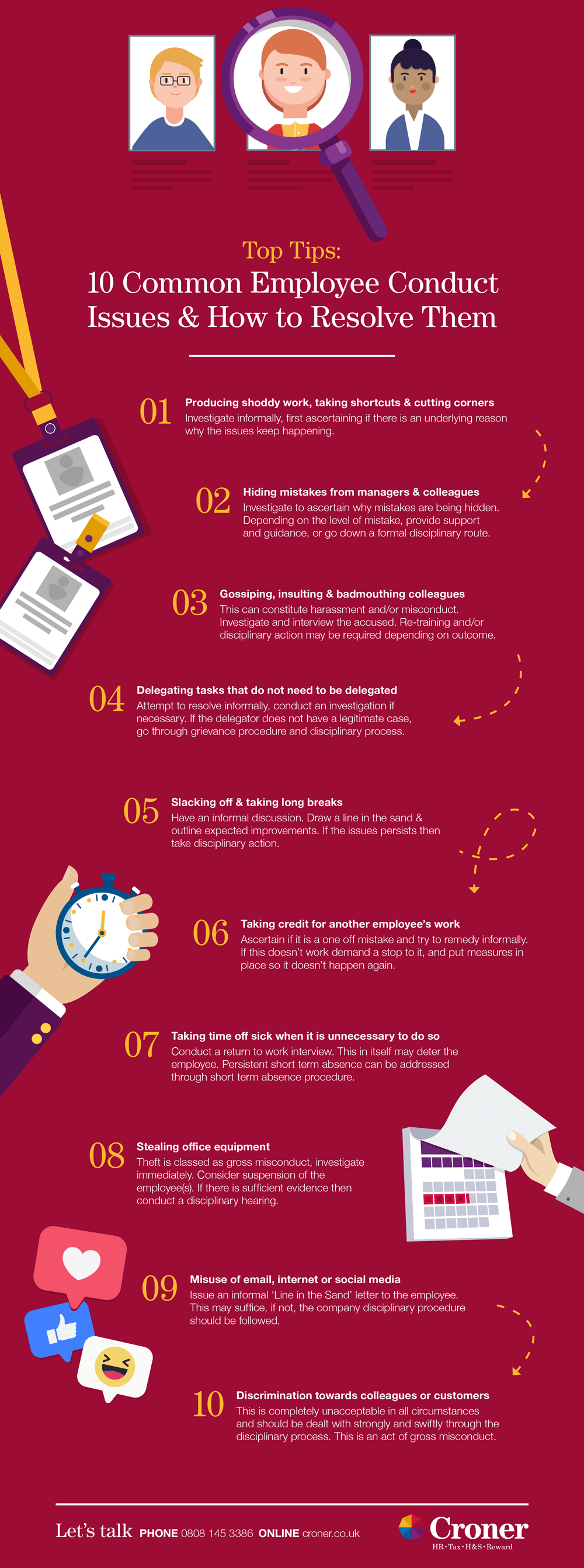Add this infographic to your website by copying and pasting the following embed code:
10 Common Employee Conduct Issues & How to Resolve Them
We’ve produced more detailed answers to manage the conduct examples you see above. If you want further guidance on how to deal with them, read on:
1. Producing shoddy work, taking shortcuts and cutting corners
It might not always be the case, but this type of staff conduct is often wilful. Investigate informally, first ascertaining if there is an underlying reason why the issues keep happening. If there is a genuine mistake, hold an informal meeting to address it. If the conduct is wilful or consistent go through the disciplinary process for conduct, following the investigation.
2. Hiding mistakes from managers and colleagues
Hiding a mistake suggests a capability issue. So how do you respond when an employee makes a mistake? You conduct an investigation to ascertain why the mistakes are being made and why they are being hidden. Depending on the level of mistake, there could be informal approach where you offer support and guidance. If it’s more serious, a formal disciplinary route might be appropriate.
3. Gossiping, insulting & badmouthing colleagues
This can constitute harassment and varying levels of misconduct dependent on the facts. Can you fire an employee for gossiping? Yes, if the employee raises a and you investigate thoroughly. Make sure you hold interviews with the accused to give them a chance to explain their actions. Re-training and/or disciplinary action may be required depending on the severity of the harassment.
4. Delegating tasks that do not need to be delegated
If this issue comes to you and cannot be resolved informally, then an investigation may be necessary. If the delegator does not have a legitimate case, raise a grievance through the company grievance procedure and take appropriate action, including formal disciplinary process.
5. Slacking off and taking long breaks
Examples of conduct that constitute slacking off include:
- Arriving late/early or taking longer breaks (including toilet breaks)
- Sleeping at work
- Chatting with colleagues for long periods of time
If this occurs, and is affecting productivity, the manager should have an informal discussion with the employee. They may draw a line in the sand, and outline expected improvements. Subsequent instances may require a performance improvement plan. If the issues persists then disciplinary action may need to be considered.
6. Taking credit for another employee’s work
Speak to the individual to ascertain if it is a one off or mistake or regular issue and try to remedy informally. If unable to remedy speak to your manager who will speak to the individual and demand a stop to it. Then put measure in place so it doesn’t happen again in the future.
7. Taking time off sick when it is unnecessary to do so
Conduct a return to work interview. This in itself may deter the employee. Persistent short term absence can be addressed through short term absence procedure. Involve, where appropriate, an occupational health specialist and obtain medical evidence if absences become frequent.
8. Stealing office equipment
Theft is classed as gross misconduct. If you have an employee caught stealing, take immediate action to investigate and understand the situation. Consider suspension of the employee(s) concerned to manage risk. If the investigation provides sufficient evidence, such as the employee caught stealing on camera, then this should be taken to a disciplinary hearing. Gross misconduct is grounds for immediate dismissal.
9. Misuse of email, internet or social media.
If you don’t already, create a policy around this area. If there is misuse of social media at work, an informal ‘Line in the Sand’ might suffice. This is a letter that lets the employee know that their actions are unacceptable. If this doesn’t put an end to the issue, or the misuse is more severe, you should follow your disciplinary procedure.
10. Discrimination towards colleagues or customers
This is completely unacceptable in all circumstances and should be dealt with strongly and swiftly through the disciplinary process. This is an act of gross misconduct.
Expert support with employee conduct
Employee conduct, or staff misconduct, is an issue every employer has to contend with. If handled incorrectly it can lead to costly tribunal claims, a hit to staff morale, and damage to your company reputation.
Fortunately, you don't have to deal with it alone. At Croner, we’re experts at managing employee conduct, conflict, and culture.
You can receive HR advice today from an employment law expert by calling 01455 858 132.
Related resources
Categories
- Business Advice
- Contracts & Documentation
- Culture & Performance
- Disciplinary & Grievances
- Dismissals & Conduct
- Employee Conduct
- Employment Law
- End of Contract
- Equality & Discrimination
- Health & Safety
- Hiring & Managing
- Leave & Absence
- Managing Health & Safety
- Moving
- Occupational Health
- Pay & Benefits
- Recruitment
- Risk & Welfare




